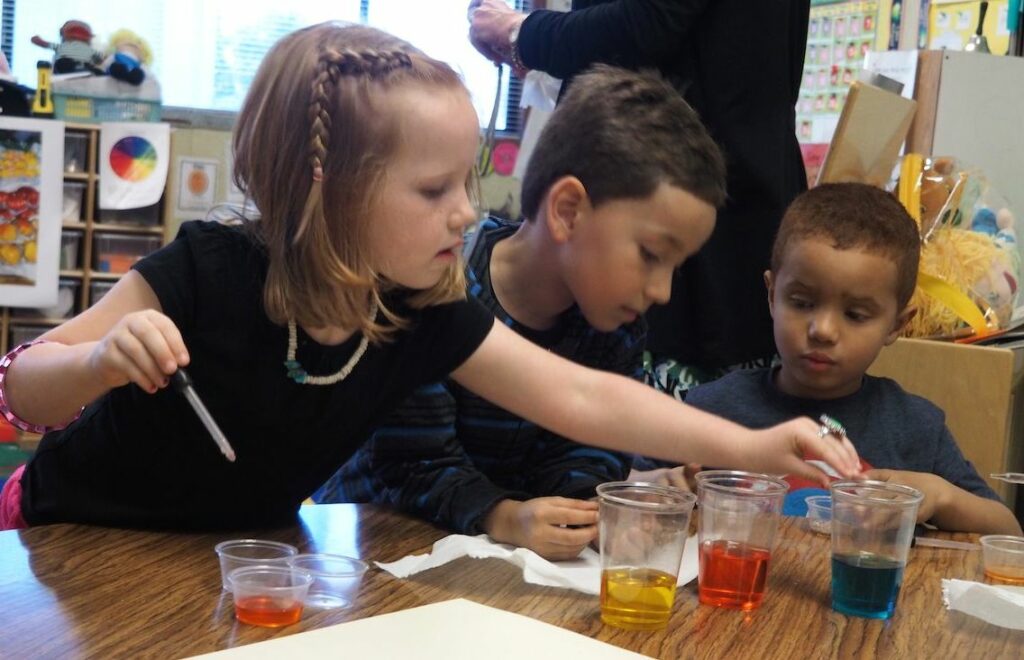
Black teachers: How to recruit them and make them stay

Lessons in higher education: What California can learn

Keeping California public university options open

Superintendents: Well-paid and walking away

The debt to degree connection

College in prison: How earning a degree can lead to a new life

Most classrooms in California’s transitional kindergarten program are stand-alone classes that may better prepare children for kindergarten than classes that combine transitional kindergarten and kindergarten students, according to a report released Wednesday.
Transitional kindergarten is a separate program for 4-year-olds who turn 5 between Sept. 2 and Dec. 2 and miss the cut-off date for kindergarten. However, some schools combine those 4-year-olds in classes with kindergarten students, often because they have too few transitional kindergarten students to create separate classes.
The new report, Transitional Kindergarten in California, by the nonpartisan, nonprofit American Institutes for Research, follows an all-out effort by state legislators and early education advocates to preserve transitional kindergarten. Gov. Jerry Brown had proposed eliminating the program in the 2016-17 state budget, but a deal with lawmakers preserved it.
The program cost $726 million in the 2015-16 school year, with 83,000 children enrolled.
The new report is the latest in a series by American Institutes for Research that examines the state’s transitional kindergarten program. Its findings show a dramatic increase in the number of stand-alone classes being offered. In the 2014-15 school year, 76 percent of transitional kindergarten classes were separate, compared with a year earlier when 22 percent of transitional kindergarten classes were separate, according to the California Department of Education.
“We fear that that’s an ongoing challenge that could contribute to effectiveness,” said Karen Manship, a principal researcher at American Institutes for Research, speaking about teachers in combination classes having to teach students at different developmental stages.
Karen Manship, a principal researcher at American Institutes for Research and one of the report’s authors, said one possible reason separate classes may be more effective is that teachers in combination classes have to divide their attention between students at different levels of development.
“We fear that that’s an ongoing challenge that could contribute to effectiveness,” she said, noting that in the series’ earlier reports teachers reported difficulties “differentiating instruction” for transitional kindergarten and regular kindergarten students.
Erin Gabel, deputy director for First 5 California, which helped fund the American Institutes for Research project, said the value of the latest report is that it provides solid data to help separate “myth from reality” about transitional kindergarten amid a national debate about how and in what form to advance pre-K–12 education.
First Five, which is funded by tobacco tax revenue, advocates for children ages 0 to 5. Other funders were the David and Lucile Packard Foundation and the Heising-Simons Foundation.
An EdSource survey of 30 school districts published in April found that most of them are moving toward creating separate classes for transitional kindergartners, as opposed to combined classes. Half of the districts offered only stand-alone classes; those that offered both stand-alone and combined classes had more stand-alone; and just two districts relied primarily on combination classes.
The American Institutes for Research report also concluded that stand-alone transitional kindergarten classes offer a more balanced curriculum and a more developmentally appropriate experience for children than combination classes.
“We know from previous research that this balanced curriculum is good for kids,” said Manship. A balanced curriculum includes music, social sciences and art, as well as English literacy and mathematics, she said. “In (stand-alone) TK, the teachers feel that they have more time to incorporate those things because they know the kids have another year of kindergarten.” In combined classes, she added, teachers feel more pressure to prepare kindergarten students for 1st grade.
The new report is the fifth in a series that has looked at how California’s transitional kindergarten program was implemented and what impact it has had on children who attend. Three more reports are scheduled, including one due in February 2017 that analyzes all the earlier findings. An American Institutes for Research report released in December said that students who attend transitional kindergarten perform better on language, literacy and math skills when they start kindergarten.
The latest report delves into teacher education levels and curriculum components, among other topics. These are among the other findings:
The findings about the number of teachers with preschool experience was “notable,” said Kim Pattillo Brownson, managing director of policy and advocacy at The Advancement Project, a children’s civil rights organization.
“There is a positive trickle-up phenomenon happening,” she said, “where teachers are now bringing the benefits of their preschool teaching experience to K-12 and ensuring that our children learn both hard skills, like early literacy and numeracy, and also socio-emotional competency, self-regulation and executive function, all of which have long been hallmarks of good early childhood teaching. Our kids need both sets of competencies to succeed.”
Manship said the conclusion that stand-alone classrooms “may be conducive” to better kindergarten preparedness was not more definitive because more research and analysis is needed. Researchers observed 184 classrooms for two hours each to reach their conclusions for the latest report, and conducted a survey of 200 teachers.
The Heising-Simons Foundation provides funding to EdSource but has no control over its editorial content.

Legislation that would remove one of the last tests teachers are required to take to earn a credential in California passed the Senate Education Committee.

Part-time instructors, many who work for decades off the tenure track and at a lower pay rate, have been called “apprentices to nowhere.”

A bill to mandate use of the method will not advance in the Legislature this year in the face of teachers union opposition.

Nearly a third of the 930 districts statewide that reported data had a higher rate of chronic absenteeism in 2022-23 than the year before.
Comments
Comments Policy
We welcome your comments. All comments are moderated for civility, relevance and other considerations. Click here for EdSource's Comments Policy.